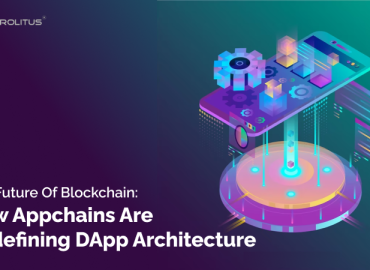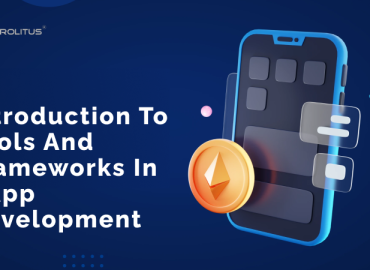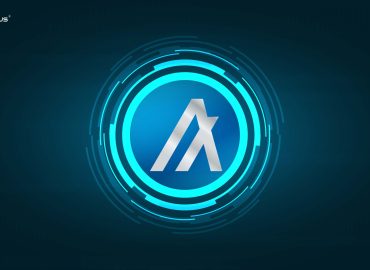Introduction to Appchains: Unleashing Decentralized App Development
The world of blockchain technology has revolutionized how we conceive and develop decentralized applications (DApps). While traditional blockchains have provided a secure and transparent foundation for DApp deployment, a new player has emerged on the scene – Appchains. These innovative and highly specialized blockchain networks are rapidly gaining attention for their ability to supercharge the world of decentralized app development.
In this blog post, we embark on a journey to explore the immense power and potential of Appchains in the realm of DApp development. We’ll delve into what Appchains are, their distinguishing features, and how they are poised to reshape the landscape of decentralized applications.
Appchains are not just an evolution; they represent a paradigm shift. They bring scalability, flexibility, and tailored solutions to the challenges faced by traditional blockchains when it comes to hosting and running DApps. Whether you’re a blockchain enthusiast, a developer looking to build the next generation of decentralized applications, or simply curious about the latest trends in blockchain technology, this exploration of Appchains is sure to provide valuable insights into the future of decentralized app development. So, fasten your seatbelts as we unlock the potential of Appchains and uncover the limitless possibilities they offer to developers and users alike.
The Building Blocks of Appchains: A Comprehensive Overview
To truly grasp the power and potential of Appchains in decentralized app development, it’s essential to start with a solid understanding of their foundational building blocks. In this section, we’ll provide a comprehensive overview of the key elements that constitute Appchains and make them unique in the world of blockchain technology.
- Consensus Mechanisms: Just like traditional blockchains, Appchains rely on consensus mechanisms to validate and record transactions. However, Appchains often employ consensus algorithms that are specifically tailored to their use cases. These can include proof-of-stake (PoS), delegated proof-of-stake (DPoS), and other variations that enhance scalability and energy efficiency.
- Token Standards: Appchains often introduce their own token standards, distinct from those found on major blockchains like Ethereum. These standards define how tokens are created, transferred, and managed within the Appchain’s ecosystem. They can be specifically designed to cater to the needs of the applications hosted on the Appchain.
- Sharding and Scaling Solutions: Appchains excel in addressing one of the most pressing challenges in blockchain technology – scalability. They often incorporate sharding techniques and layer 2 scaling solutions to process transactions faster and more efficiently, ensuring that DApps can handle a growing user base without sacrificing performance.
- Governance Models: Governance in Appchains varies widely and is often community-driven. Decisions about upgrades, changes to consensus mechanisms, and the addition of new features are typically made through on-chain governance mechanisms, allowing the Appchain’s community to have a direct say in its evolution.
- Security Measures: Security is paramount in Appchains. They implement robust security measures to protect both the network and the DApps hosted on it. These measures can include advanced cryptography, bug bounties, and regular security audits.
- Developer Tools: To facilitate the development of DApps on Appchains, a suite of developer tools and SDKs (Software Development Kits) is made available. These tools streamline the development process, making it easier for developers to create, deploy, and maintain DApps on the Appchain.
- User-Friendly Interfaces: Appchains aim to enhance the user experience by providing user-friendly interfaces and wallets. This lowers the entry barriers for non-technical users and encourages wider adoption of DApps.
By comprehensively understanding these building blocks, developers and enthusiasts alike can appreciate how Appchains differ from traditional blockchains and why they hold such promise for the future of decentralized app development. In the following sections, we will dive deeper into how each of these elements contributes to the unique capabilities of Appchains.
Harnessing the Potential: How Appchains Empower Decentralized Apps
Appchains are more than just a novel concept; they are powerful tools that empower decentralized applications (DApps) in numerous ways. In this section, we will delve into the specific ways in which Appchains unleash their potential to drive innovation and efficiency in the world of DApp development.
- Scalability: Appchains are designed to tackle one of the most significant challenges faced by traditional blockchains – scalability. By implementing sharding, layer 2 scaling solutions, or other specialized techniques, Appchains can process a high volume of transactions concurrently. This scalability ensures that DApps can handle an ever-expanding user base without experiencing delays or increased transaction costs.
- Customization: Unlike one-size-fits-all blockchains, Appchains can be tailored to the specific needs of DApps. Developers can choose consensus mechanisms, token standards, and governance models that align with their project’s objectives. This level of customization enables DApp creators to optimize their blockchain environment for performance, security, and functionality.
- Efficiency: Appchains often employ consensus algorithms that are more energy-efficient than traditional proof-of-work (PoW) mechanisms. This not only reduces the carbon footprint but also lowers transaction costs, making DApps more accessible to users and developers.
- Speed and Throughput: Appchains can process transactions at blazing speeds, allowing for near-instant confirmations. This enhanced throughput is crucial for applications that require quick response times, such as gaming, finance, and real-time data feeds.
- Enhanced Security: Appchains prioritize security, implementing advanced cryptographic techniques and regular security audits. This focus on security reduces the likelihood of hacks and vulnerabilities, instilling trust in both developers and users.
- Developer-Friendly Ecosystem: Appchains offer developer-friendly tools, SDKs, and documentation to simplify the DApp development process. This encourages more developers to participate in the ecosystem, leading to a diverse range of innovative DApps.
- User Adoption: User-friendly interfaces and wallets provided by Appchains make it easier for non-technical users to access and interact with DApps. The improved user experience can drive wider adoption of decentralized applications.
Appchains are a game-changer for decentralized app development. Their scalability, customization, efficiency, and security features, coupled with their support for cross-chain interoperability, create an ecosystem where DApps can thrive. Developers and users alike are benefiting from the potential harnessed by Appchains, ushering in a new era of decentralized innovation and creativity.
Appchains vs. Traditional Blockchains: A Comparative Analysis
In the ever-evolving landscape of blockchain technology, Appchains have emerged as a promising alternative to traditional blockchains. To gain a deeper understanding of their impact, let’s conduct a comparative analysis between Appchains and traditional blockchains across several key dimensions.
Scalability:
- Appchains: Appchains excel in scalability. They often implement sharding, sidechains, or layer 2 solutions to process transactions in parallel, significantly boosting throughput and reducing congestion.
- Traditional Blockchains: Traditional blockchains like Bitcoin and Ethereum face scalability challenges due to their linear transaction processing, resulting in slower confirmation times and higher fees during network congestion.
Customization:
- Appchains: Appchains are highly customizable. Developers can tailor consensus mechanisms, token standards, governance models, and other parameters to suit the specific requirements of their DApps.
- Traditional Blockchains: Traditional blockchains have standardized protocols and limited flexibility, making it challenging to adapt them to diverse DApp needs.
Consensus Mechanisms:
- Appchains: Appchains often employ energy-efficient consensus mechanisms like proof-of-stake (PoS) or delegated proof-of-stake (DPoS), reducing environmental impact and enabling faster transaction validation.
- Traditional Blockchains: Many traditional blockchains, especially Bitcoin, rely on energy-intensive proof-of-work (PoW) consensus, leading to environmental concerns and slower transaction processing.
Interoperability:
- Appchains: Appchains are often designed with interoperability in mind. They can facilitate cross-chain communication, allowing DApps to interact with assets and data from multiple blockchain networks.
- Traditional Blockchains: Achieving interoperability between traditional blockchains can be complex and is typically accomplished through bridging solutions or atomic swaps.
Security:
- Appchains: Appchains prioritize security and often undergo rigorous security audits. Advanced cryptographic techniques and community-driven governance contribute to a robust security posture.
- Traditional Blockchains: Established blockchains like Bitcoin and Ethereum have strong security, but they can still be vulnerable to attacks or vulnerabilities.
Developer-Friendly Tools:
- Appchains: Appchains typically provide developer-friendly tools, SDKs, and documentation to ease the DApp development process, encouraging more developers to participate.
- Traditional Blockchains: While traditional blockchains have matured over time, they may have a steeper learning curve for developers, especially newcomers.
In conclusion, Appchains offer a compelling alternative to traditional blockchains, particularly for DApp developers seeking scalability, customization, efficiency, and interoperability. However, the choice between Appchains and traditional blockchains should be based on the specific needs of a project, as each has its own strengths and limitations. As the blockchain ecosystem continues to evolve, both Appchains and traditional blockchains will play essential roles in shaping the future of decentralized applications.
The Future of Decentralized App Development: Appchains Leading the Way
The future of decentralized app development is poised for a significant transformation, with Appchains emerging as a leading force in shaping this evolution. As we look ahead, it becomes evident that Appchains are well-positioned to play a pivotal role in realizing the full potential of decentralized applications (DApps). Here’s why Appchains are set to lead the way in the future of DApp development:
- Scalability without Compromise: Appchains, by design, prioritize scalability. They offer solutions like sharding and layer 2 scaling that allow DApps to handle a massive number of transactions without compromising on speed or cost-efficiency. This scalability is crucial as DApps gain mainstream adoption.
- Customized DApp Ecosystems: Appchains enable developers to create customized blockchain ecosystems tailored to the specific needs of their DApps. This flexibility ensures that DApps have the right infrastructure and rules in place to thrive in their respective niches.
- Energy Efficiency: In an era where sustainability is a growing concern, Appchains often employ energy-efficient consensus mechanisms such as proof-of-stake (PoS) or delegated proof-of-stake (DPoS). This not only reduces the environmental impact but also makes DApps more appealing due to lower energy costs.
- Enhanced Security Measures: Security remains a paramount concern for DApp developers and users. Appchains are committed to implementing advanced cryptographic techniques, regular security audits, and community-driven governance to fortify the security of the ecosystem.
- Community-Driven Innovation: Many Appchains embrace community-driven governance models, giving users and developers a say in the network’s direction. This fosters innovation and ensures that the Appchain evolves in response to real-world needs.
- Developer Support: Appchains provide a range of developer-friendly tools and resources, making it easier for developers to create, deploy, and maintain DApps. This support system encourages more developers to enter the ecosystem and contribute to its growth.
- User-Friendly Experiences: The user experience is a significant driver of DApp adoption. Appchains are dedicated to creating user-friendly interfaces and wallets that make it accessible for non-technical users to engage with DApps seamlessly.
In conclusion, the future of decentralized app development is undeniably bright, with Appchains leading the way. Their scalability, customization, energy efficiency, and commitment to security position them as a catalyst for innovation in the blockchain ecosystem. As Appchains continue to mature and gain adoption, they will undoubtedly pave the path for a new era of DApps that are faster, more efficient, and more accessible to users worldwide. Developers and enthusiasts alike should keep a close eye on the evolution of Appchains as they shape the future of decentralized application development.
The Final Thought: Embracing the Revolutionary Potential of Appchains
In conclusion, the world of blockchain technology is witnessing a remarkable transformation, and at the forefront of this revolution are Appchains. These innovative blockchain networks are redefining the possibilities for decentralized app (DApp) development, offering a host of benefits that have the potential to reshape the way we interact with digital applications and services.
As we look to the future, it’s clear that Appchains are poised to lead the way in decentralized app development. Their transformative potential is driving forward a new era of DApps that are scalable, efficient, secure, and accessible to users across the globe. Developers and enthusiasts should embrace this revolutionary technology, as it holds the promise of unlocking unprecedented opportunities and ushering in a more decentralized, inclusive, and innovative digital landscape. By harnessing the power of Appchains, we can collectively shape a more decentralized and empowering digital future.





